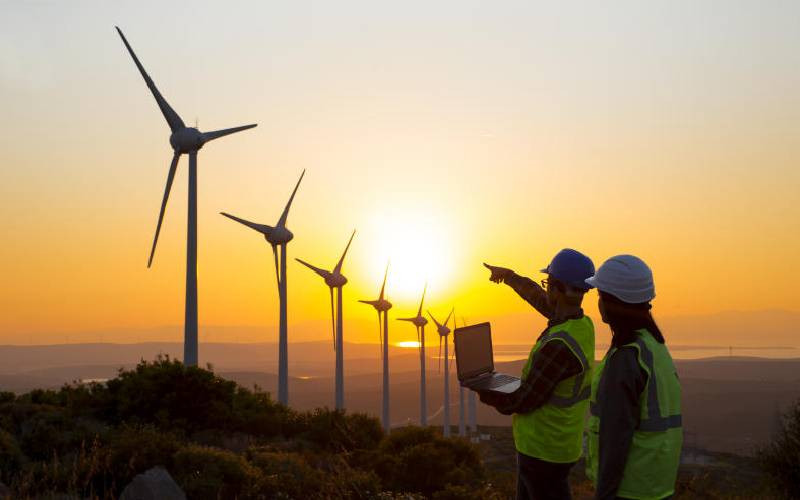Deep in the valleys of Oldonyo Orok located in Bissil, Kajiado, Moses Ole Koisabar switches on his house lights at night and the whole boma is lit.
The light, powered by a solar panel mounted on his mud walled and mabati roofed house is used in three other manyattas and also lights his boma, providing enhanced security to his prized animals hence keeping away predator.
“Since I installed the solar systems my livestock have not been attacked by hyenas and leopards, which roam the whole of this valley,” Ole Koisabar says. “And my children now can study at night with proper lights,” he adds as a matter of fact.
The evolution in the clean energy space has seen a rapid uptake of various solutions that have been deployed to provide lighting and clean cooking.
To meet the emerging needs and financial abilities of most rural households, some providers are offering pay-as-you-use solutions.
This has enabled majority of people to purchase power tokens which then activates their solar systems. The model adopted here is similar to the mobile telephony airtime top up.
Globally, it’s reported that slightly over three billion people cook over open fire or traditional cooking stoves that burns heavy polluting fuels like charcoal, kerosene, wood, animal dungs among others.
Cooking this way causes serious health and environmental impacts, disproportionately affecting the lives and livelihoods of women and children.
According to the World Health Organisation (WHO), traditional cooking methods contributes to the preventable death of 2.6 million people each year and sickens million more. In Sub Saharan Africa, 550,000 are estimated to die from respiratory diseases related to smoke from indoor cooking fires.
In addition, firewood and charcoal production are responsible for than 52% of forest loss in Sub Saharan Africa.
Here in Kenya, the battle to save the Mau Escarpment has degenerated into a political fight as the government attempts to remove people whom it had settled in the same area.
Cost wise, it’s estimated that 85 per cent of urban households uses charcoal, spending up to Sh50,000 per year.
It is said that charcoal is used by 13 billion users, kerosene two billion users and liquefied petroleum gas (LPG) 5 billion users. Besides, it has placed the burden of fetching of firewood, burning of charcoal on women and the girl child.
On the cooking front, we have seen the development and adoption of a motley of innovative solutions that have not only lifted the burden on our women and girls but also improved the health situation on most households.
Recently, the Kenya Association of Manufacturers (KAM) held Clean Energy Efficiency Conference (CEEC), where various innovative clean cooking solutions were displayed.
Stay informed. Subscribe to our newsletter
For instance, Burn Manufacturers produces a cooking stove called JikoKoa that uses less charcoal, burns for long and has no emission. Other innovative solution developed to address the biofuel menace is a cooking stove that uses ethanol in place of the normal LPG.
Similarly, the high cost for solar panels has seen slow uptake by most households which are out of the national grid network.
To mitigate this, the government of Kenya together with the World Bank have rolled out the Kenya Off Grid Solar Program (KOSAP) which is expected to install solar mini grids in most rural areas hence enhancing access to power.
This is expected to bring affordable light to the likes of Mzee Koisabar who may not be able to afford solar systems.
The writer, Johnstone Ole Turana, is the Principal Lead at QLand Energy Communications Consultancy.
 The Standard Group Plc is a
multi-media organization with investments in media platforms spanning newspaper
print operations, television, radio broadcasting, digital and online services. The
Standard Group is recognized as a leading multi-media house in Kenya with a key
influence in matters of national and international interest.
The Standard Group Plc is a
multi-media organization with investments in media platforms spanning newspaper
print operations, television, radio broadcasting, digital and online services. The
Standard Group is recognized as a leading multi-media house in Kenya with a key
influence in matters of national and international interest.
 The Standard Group Plc is a
multi-media organization with investments in media platforms spanning newspaper
print operations, television, radio broadcasting, digital and online services. The
Standard Group is recognized as a leading multi-media house in Kenya with a key
influence in matters of national and international interest.
The Standard Group Plc is a
multi-media organization with investments in media platforms spanning newspaper
print operations, television, radio broadcasting, digital and online services. The
Standard Group is recognized as a leading multi-media house in Kenya with a key
influence in matters of national and international interest.









